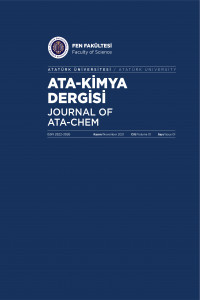Ozon Yağı İçeren Nanoteknolojik Yara Örtüsü Üretimi ve Karakterizasyonu
Ozan yağı, polivinil alkol, elektroeğirme, yara örtüsü, diyabet
Production and Characterization of Nanotechnological Wound Dressing Containing Ozone Oil
Ozone oil, polyvinyl alcohol, electrospinning, wound dressing, diabetes,
___
- [1] Cascone, S., Lamberti, G., “Hydrogel-based commercial products for biomedical applications: A review”, International journal of pharmaceutics, (2020), 573, 118803.
- [2] Homaeigohar, S., Boccaccini, A. R., “Antibacterial biohybrid nanofibers for wound dressings”, Acta biomaterialia, (2020),107, 25-49.
- [3] Mutlu, S., & Yılmaz, E., “Yara Yönetiminde Güncel Yaklaşımlar”, Gümüşhane Üniversitesi Sağlık Bilimleri Dergisi, (2019), 8(4), 481–494.
- [4] Dhivya, S., Vijaya, V., Santhini, E., “Review article Wound dressings – a review”. Biomedicine (Taipei), (2015), 5(4), 24–28.
- [5] Vowden, K., & Vowden, P., “Wound dressings: principles and practice”, Surgery (United Kingdom), (2017), 35(9), 489–494.
- [6] Buluş, E., Buluş, G. S., Akkaş, M., “Investigation of the Effects of Working Parameters in Electrospinning Technology on Morphology of Polymeric Nanofiber Membranes Using Reference Polymers”. Journal Of Materıals And Electronıc Devıces, (2021), 2(1), 6-11.
- [7] Bunn, C. W. “Crystal structure of polyvinyl alcohol”, Nature, (1948),161(4102), 929-930.
- [8] Buluş, E., Buluş, G. S., “The Effect of Ozone and Platelet Rich Plasma (PRP) Methods on Hip Prosthesis Healing Process”, Journal Of Materials And Electronic Devices, (2020), 5(1), 17-19.
- [9] Aynali, F., Balci, H., Doganci, E., & Bulus, E., “Production and characterization of non-leaching antimicrobial and hydrophilic polycaprolactone based nanofiber mats”, European Polymer Journal, (2021), 149, 110368.
- [10] Yan, J., Su, Q., Xiao, W., Wu, Z., Chen, L., Tang, L., Xue, H., “A review of nanofiber membranes for solar interface evaporation”, Desalination, (2022), 531, 115686.
- [11] Koyutürk, A., Soyaslan, D. D., “Yara ve Yanık Tedavisinde Kullanılan Örtüler”. Mehmet Akif Ersoy Üniversitesi Fen Bilimleri Enstitüsü Dergisi, (2016), 0(1), 58-65–65.
- [12] Bhardwaj, N., & Kundu, S.C., “Electrospinning: A fascinating fiber fabrication technique”, Biotechnology Advances, (2010), 28(3):325-347.
- [13] Pinzón-García, A. D., Cassini-Vieira, P., Ribeiro, C.C., “Efficient cutaneous wound healing using bixin-loaded PCL nanofibers in diabetic mice”, Journal of Biomedical Materials Research - Part B Applied Biomaterials, (2017), 105(7):1938-1949.
- [14] Buluş, E., Buluş, G. S., Akkaş, M., & Çetin, T. “Production and Morphological Characterization of Nanofiber Membrane with Natural Wound Healing”, Journal Of Materıals And Electronıc Devıces, (2021), 2(1), 1-5.
- [15] Majd, S. A., Khorasgani, M. R., Moshtaghian, S. J., Talebi, A., & Khezri, M., “Application of Chitosan/PVA Nano fiber as a potential wound dressing for streptozotocin-induced diabetic rats”, International journal of biological macromolecules, (2016), 92, 1162-1168.
- Başlangıç: 2021
- Yayıncı: Atatürk Üniversitesi
Yeni 4-(2-aminoetil)morfolin substitüe siklotrifosfazenin sentezi ve yapı analizi
Elif YILDIZ GÜL, Merve BAL, Buse KÖSE, Esra TANRIVERDİ EÇİK
Santa Maria armudu püresinde LOX aktivitesi üzerine bazı katkı maddelerinin inhibisyon etkileri
Arzu ÖZTÜRK KESEBİR, Işıl Nihan KORKMAZ, Ömer İrfan KÜFREVİOĞLU
Paraben Sübstitüe Monospiro-Siklotrifosfazen Bileşikleri: Sentezi ve Karakterizasyonu
Nagihan BAYIK TÜLÜCE, Gönül YENİLMEZ ÇİFTÇİ
Fatih BİRYAN, Kenan KORAN, Ahmet Orhan GÖRGÜLÜ
Ozon Yağı İçeren Nanoteknolojik Yara Örtüsü Üretimi ve Karakterizasyonu
Erdinc DOGANCI, Merve DANDAN DOGANCI, Gulseren SAKARYA BULUS, Erdi BULUS
